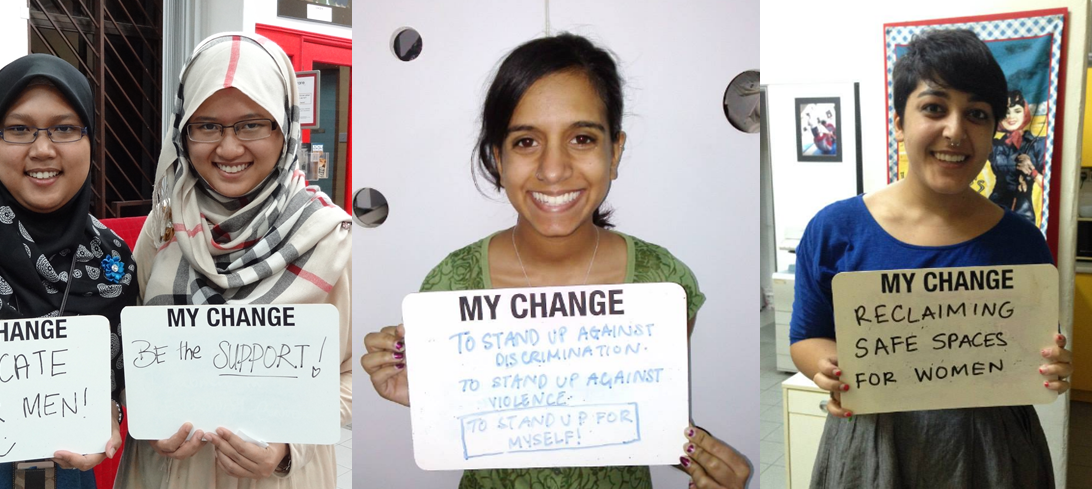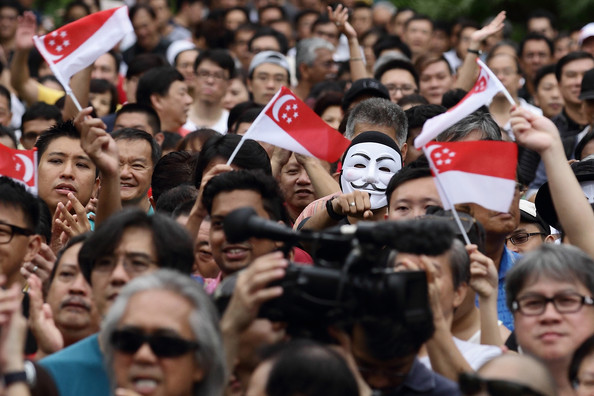Protests are springing up across the globe since the inauguration of the tweet-happy King of Petty and his weeklong reign of #AlternativeFacts. From the millions that showed for the Women’s March to the people flooding the airports to protest the Muslim Ban - can any of us remember the last time the public mobilised in such staggering numbers?
Halfway across the world in Singapore, watching the news roll in, you might be feeling a little helpless. Or maybe even a little removed from the situation. After all, it’s not like we can stage our own protest because of post-CNY food comas... and other more law-entrenched reasons.
But even in the face of Trump’s executive order horrors, you can’t help but see the slight silver lining in all of this. Lawyers holding signs at the airport offering their services pro bono, Google putting together a crisis fund, Airbnb offering free housing to those affected by Trump’s executive orders… humanity is coming through.
There are ways to show solidarity from a distance. If you feel so inclined, you can donate to the <a href=" Anti-Racist Collaboration or the ACLU. If not, that’s okay too. There are causes closer to home that could use our help.
Migrant Workers
Home
They are crucial to the day-to-day running of Singapore, but so often marginalised and forgotten. This country relies on low-skilled foreign workers to take on tasks most wouldn’t deign to do, and the least we can do is lend a hand in making their voices heard. Home (Humanitarian Organisation for Migration Economics) is a registered charity that helps raise awareness around migrant worker rights and advocates for foreign workers who’ve been unfairly treated by employers. They funnel donations into providing shelter, legal assistance, upskilling workers and holding educational seminars for both migrants and Singaporeans. Visit www.home.org.sg to see how you can get involved.
Itsrainingraincoats
Itsrainingraincoats is a local initiative that supports migrant workers by (you guessed it!) providing them with raincoats. Founder and lawyer Dipa Swaminathan was moved after witnessing a group of workers on a construction site in a thunderstorm, chipping away with only garbage bags as shelter. A strong advocator of their well being, she now organises donation drives and gives out items like raincoats and sim cards to migrant workers in Singapore. Small acts of kindness make a big difference - visit https://www.facebook.com/pg/itsrainingraincoats/ to see what you can do!
Gender Equality
Casa Raudha
Casa Raudha is a women’s home - a haven for those who’ve been abandoned, abused or simply have nowhere to go. They provide computer rooms and an art therapy room, as well as a playground for children. Casa Rauda also runs various workshops and entrepreneurship programs for these women, returning a sense of agency to their lives. Financial aid, medical assistance and counselling are among the services provided. Head over to www.casaraudha.org to find out how you can get involved - volunteers are always welcome!
We Can! Singapore
This organisation takes a stand against discriminatory attitudes and violence toward women. It’s part of a larger, global campaign that is spread across countries like Tanzania, Kenya, India and Afghanistan. Its goal is to promote healthy relationships and gender equality via interactive theatre and workshops with various local collaborators. How can you get involved? Throw your support behind the White Ribbon Campaign - you can volunteer, take the pledge or donate to the cause - <a href="
Aware
The last time you may have heard Aware (Association of Women for Action and Research) surfacing might've been in the high profile Teenage Magazine scuffle of last year. This group is a strong advocate of equal opportunities for both men and women - in education, employment and also in terms of sex and reproductive rights. They run corporate and school programs, support groups and counselling for victims of sexual violence, a free legal clinic as well as extensive research projects. There are numerous ways to get involved - Aware offers internships on top of the usual donation and volunteering avenues -
We may not be facing anything as drastic as a ban on an entire religion or an assault on women’s reproductive health. Regardless, there are enough issues at hand where we can put our money where our mouth is. January has seen 2017 with a rocky start, but hopefully with a bit of compassion, it’s only up from here!
Since 21 January 2017, in response to Donald Trump’s inauguration as President of the United States, a series of political rallies known as Women’s Marches occurred around the world to promote women’s rights.
The movement began in Washington, D.C. and spread to 673 marches in 34 countries worldwide, including Asian countries Japan, South Korea, and India, with global attendance numbering in the millions.
Singapore, however, is not on that list of countries.
Of course, one could be content with the explanation that the Trump issue is too far removed from our shores for us to care enough. However, as one of Asia’s most developed nations alongside Japan and South Korea, and one with a large American expatriate and student population, Singapore’s absence from such a major global movement should surely raise the glaring issue of free expression and the right to dissent in Singapore.
As many of you should know, protesting is illegal in Singapore outside of licensed protests in Hong Lim Park’s Speakers’ Corner. If that sentence made you frown in confusion or laugh out loud, you’re probably not Singaporean. “Protesting is illegal”, “licensed protests”, “Speakers’ Corner” – it all sounds like a bad comedy – one that Singaporeans have grown numb to.
Around the world, Singapore is known as an Orwellian dystopia of silent obedience, where almost all dissent is effectively repressed by the law, draconian punishments are meted out in disproportionate spades, and everyone is so used to the oppression that the country actually operates rather peacefully; it’s almost like a North Korea done right.
Ask any citizen of almost any other “first-world” nation if protesting is legal in their country, and the answer will almost invariably be, “Of course, why wouldn’t it be?” The right to dissent is seen elsewhere as a basic human right. Not here, though.
Some would argue that the restricting of protests is necessary for socioeconomic stability in a country, but as all the developed nations of the world that afford their citizens the freedom to protest highlight, that is all a crock of shit. Stability and freedom of expression are not mutually exclusive. One needs simply to be equipped with the maturity and open mind required to handle discourse and dissenting opinion.
In any discussion about protests in Singapore, many would point to the race riots of 1964 and 1969, Hock Lee bus riots of 1955, and Chinese middle school riots of 1956, and go, “See? That’s what happens when people protest.” This argument, however, fails to consider that these events happened over 50 years ago.
A lot can change in 50 years; our society is now more educated than ever, and well-informed of events around the world. To assume that we would simply devolve into the same horrible behaviour of our forefathers given the opportunity would be incredibly pessimistic and insulting to the intelligence of modern Singaporeans as a whole. We are not rabid animals waiting to tear each other apart at the slightest provocation.
Give us a chance to voice our grievances and concerns freely, and you might find a populace living with a far more robust sense of genuine belonging and purpose. How could we possibly develop a personal stake in a place whose government operates so far above the silent voices of the people, knowing that nothing we ever do or say will make any difference?
To be fair, though, things are showing signs of getting better. In 2008, the government ruled that events held at the Speakers’ Corner would no longer require police permits, or be banned from using audio amplification devices, although organizers still had to register with the government-controlled National Parks Board. Peaceful demonstrations such as Pink Dot continue to be held there annually, attracting more attendees with each passing year. It is still comically ridiculous that protests must be restricted to one small area, but it admittedly is better than nothing.
Do I wish to see a protest happening every other day in Singapore? Of course not. I like peace and quiet. I do, however, want to know that anyone with a grievance and a desire to make his/her voice heard in a public capacity has the right to do so without fear of being thrown in prison and caned on the backside. Because any country that forces its residents to internalize all their problems instead of freely expressing themselves in a peaceful way is forcing peace and stability upon its people rather than earning it.
<a href=" Image Credit
2016 was universally a pretty crazy year. We have exclusionary and bigoted rhetoric legitimized in the West, a controversial war on drugs in the Philippines, a staggering death toll in Syria, an impeached South Korean president, and the untimely passing of pop culture icons like Carrie Fisher.
What the year did bless us with, however, apart from new Beyoncé and Gaga albums (YAAAAS), is an abundance of memes to help us grapple with the chaos 2016 relentlessly piled on our fragile minds.
Yes, memes.
While “studying” in my university library, I often find myself mindlessly scrolling through memes on Instagram and Facebook. For many, sifting through hordes of these posts has become as regular as checking for new WhatsApp messages. It’s about time we sit down and evaluate why memes are so addictive to begin with.
They are ridiculously relatable.
It’s safe to say that there are memes out there for everybody, whether you are a wine-chugging single mom of two or a procrastinating high school student. In particular, the latter half of 2016 gave birth to a slew of memes featuring Kermit the Frog in a face-to-face confrontation with his evil, hooded alter ego. This pair quickly became the icon for anything that has to do with giving in to our temptations, ranging from breaking a diet to sleeping with someone who’s off-limits. Kermit’s new meme depicts a literal reflection of the self, but most of the time, all memes actually aim to mirror different aspects of our lives, no matter how mundane. I often find myself chuckling at the surprising discovery that yes, I am not the only person in the world that thinks about eating pizza and mozzarella sticks in church. (Yes, that was a meme).They bring people together.
My dictionary defines memes as “a humorous image, video, piece of text, etc., that is copied (often with slight variations) and spread rapidly by Internet users.” And no, this ‘spread’ isn’t just the casual, impersonal click of a button. When I moved to Singapore from my hometown of Manila, I initially found it difficult to keep in touch with old friends from high school who likewise traveled to other corners of the globe for college—that was, until the recent explosion of memes. My close friends and I rarely keep in touch via long, thorough conversations on Skype. And yet, it’s hard to feel the distance when we’re constantly tagging each other in memes that make us nostalgic about our stupid high school days. The best ones always involve smuggling food into a classroom or being the only sober ones at a party. Ensue the comment: “LOL that’s so us”.They keep up with the times.
One of the reasons memes will never get boring is that they constantly renew according to real-time political or social contexts. As a result, some of the most pressing moments of 2016 could momentarily be viewed in a humorous and (almost) positive light. When Donald Trump was officially announced as the President-Elect of the United States, social media outlets were flooded with memes featuring the adorable bromance between President Obama and Vice President Joe Biden, where the latter would be depicted as hilariously petty and/or sentimental. Harmless jokes about Melania Trump’s infamous plagiarism also emerged, albeit alongside problematic slut-shaming judgments about her background. Netizens all across the world were soaking these up with glee—this was the Internet’s way of coping. While seemingly trivial, memes are artifacts of pop culture that can both reflect and impact the sentiments of their viewers. Memes are intricately connected to both banal and essential day-to-day happenings, packaging the otherwise neglected realm of politics (and other things that require brainwork) into bite-sized pieces for the general public to enjoy and share.They remind you to take yourself less seriously.
Perhaps most importantly, as a combined by-product of all of the aforementioned factors, memes can heal—even if in just the most superficial ways. I find myself drawn to memes that tap into some of the most relatable flaws: being unable to finish work on time, failing to resist sending that f*ckboy another text, and sometimes, not being able to get up in the morning because life can feel a bit overwhelming sometimes. These simple photo-caption bundles remind me that there are people out there who go through similar motions in life, albeit to varying degrees. It’s the solidarity endowed by all this Facebook tagging that puts a transient Band-Aid on the internal chaos. Memes provide the space for us to laugh through the pain, or at the very least, concretize the struggles that we never bothered to caption before. So as 2017 steps into the picture, I look forward to getting distracted from my study time by tags in more posts about gaining weight over the holidays and not having anyone to kiss on New Year’s Eve.https://www.facebook.com/Urbanites.co/posts/1785642571685041
<a href=" Image Credit

